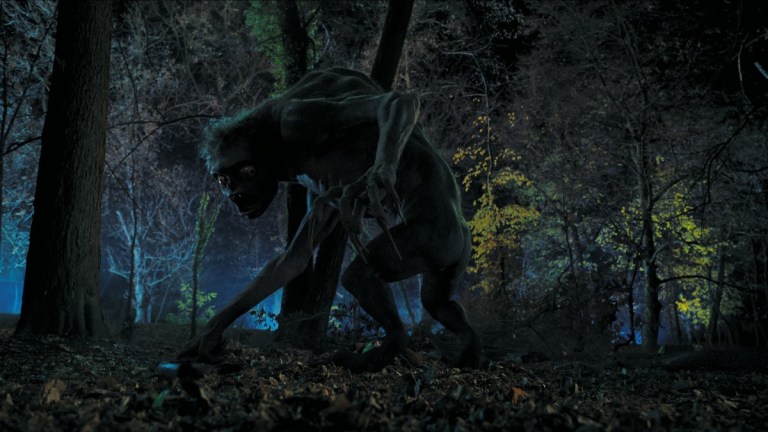Wednesday: What is a Hyde?
The Hyde on Wednesday is not a mythological creature nor an invention of Edgar Allan Poe, but a flashback to a Robert Louis Stevenson binge.

This article contains spoilers for Wednesday.
On Wednesday, Wednesday Addams (Jenna Ortega) sets out to distinguish herself from The Addams Family, and extinguish anything standing in the way. Tim Burton’s take on Charles Addams’ perennially ooky characters is unique. They don’t refract the broken mirrors of regular people. Wednesday neuters that possibility in the opening sequence, and is tossed off into a very alternative school, filled with cryptic coeds. The outcast among outcasts spends the semester trying to solve the mystery of the Hyde.
Created for the mythology of the series, the Hyde is enigmatic, symptomatic, and symbolic. Nevermore Academy’s founder, Nathaniel Faulkner, cataloged all the outcast communities of the world which would be welcome at the school, and contains a chapter on the Hyde. According to the diaries, Hydes are “artists by nature, but equally vindictive in temperament.” That could describe Nevermore’s most famous graduate, Edgar Allan Poe.
Much of Wednesday draws heavily from Poe’s works. The school dance is called the RaveN, obviously a tribute to his poem, “The Raven.” Poe also created literature’s detective genre. The Murders in the Rue Morgue was the first mystery to include a character who solved case by analyzing clues and facts, which is what Wednesday Addams does.
The Hyde, however, does not originate from a Poe story or poem. It is a loving homage to the featured secondary character in Robert Louis Stevenson’s 1886 novella The Strange Case of Dr. Jekyll and Mr. Hyde. The book is about the handsome, wealthy, and erudite chemist, Dr. Henry Jekyll, a community pillar and a living saint who treats the poorest in Victorian London, and takes no pay. He is engaged to a society lady. Dr. Jekyll takes one walk on the wild side and gets hooked on transformation. He becomes a beast who calls himself Mr. Hyde, who is wanted by the authorities for abuses around the city. The series casts him as a literary hybrid, a mythological monster who only exists in the Wednesday universe.
“Born of mutation, the Hyde lays dormant until unleashed by a traumatic event or unlocked through chemical inducement or hypnosis,” Faulkner’s diary reads in Wednesday. In Stevenson’s book, the doctor concocts a serum, which unlocks suppressed desires. After experiencing temptations he denies himself as a doctor, his chemically enhanced alter-ego, Mr. Hyde, gives in to them all, allowing Jekyll to return to his professional practice when the potion wears off.
In Wednesday, the Hyde is a lone entity who shares its identity, and receives unfair representation. Nevermore Academy is not quite the beacon of outsider inclusivity it boasts. Lycanthropes may compete against the siren rowing team, but neither would throw an anchor to a Hyde. One of its kind killed Nevermore’s founder. The Hyde is the only kind of creature banished from the school, 30 years before the start of the series. The creature is shrouded in so much coverup, Wednesday is hard-pressed to even learn its classification.
Uncle Fester (Fred Armisen) is the first to recognize the pedigree. He was quite enamored by a Hyde he’d encountered during a 1983 vacation at the Zurich Institute for the Criminally Insane. Her name was Olga Malacova, and she was everything a man like Fester could covet: brains, beauty, and a penchant for necrophilia. In her mundane form, she was a renowned concert pianist. But art doesn’t merely imitate life in the world of the outcasts, it mocks it. Malacova transformed while performing a Chopin sonata, and didn’t just kill the critics, but about a dozen audience members.
In the series, the Hyde is Tyler Galpin (Hunter Doohan), usually a mild-mannered latte foamer. Tyler’s mother was a Hyde, who attended Nevermore before the ban. Her transformation was triggered by postpartum depression. Sheriff Galpin is aware of his son’s condition, but, like everything else in his life, he is in denial.
In series canon, unlocking trauma “causes the Hyde to develop an immediate bond with its liberator, who the creature now sees as its master,” the diary explains. “It becomes the willing instrument of whatever nefarious agenda this new master might propose.” Given the homicidal mood in the forest, Wednesday believes Dr. Valerie Kinbott (Riki Lindhome) is using hypnosis to bring out Tyler’s inner Hyde.
“Anyone willing to unlock a Hyde is a next-level sicko,” Fester says. While we can’t be sure if this is a hearty endorsement of the cutting edge effrontery, considering the source, it only feeds into the mythology of the Wednesday universe.
Miss Marylin Thornhill (Christina Ricci) is able to unlock Tyler’s Hyde instincts by being the first person to tell him the truth about his mother, As the botany professor at Nevermore, she knows how to solidify the bond through a plant derivative which produces the same chemical reaction as proscribed in the diaries.
The takeaway message from The Strange Case of Dr. Jekyll and Mr. Hyde is that the only way to get rid of a temptation is to yield to it. The book is an allegory for drug addiction, and Hyde’s motto is a rally cry for relapse. Wednesday’s moral is tough love is an expedient defoliant. Wednesday is an enthusiastically budding psychopath, with little patience for amateurs.
